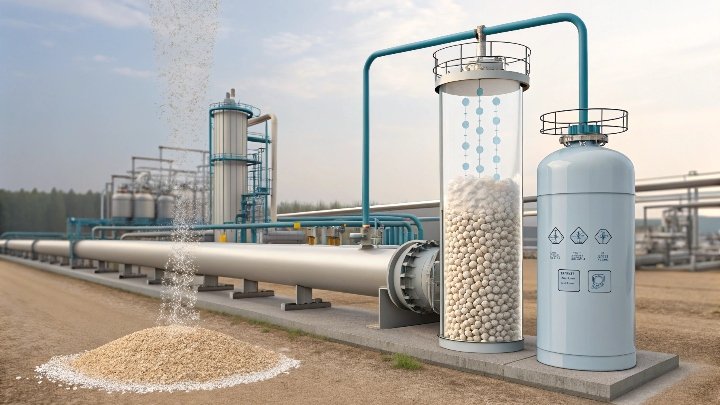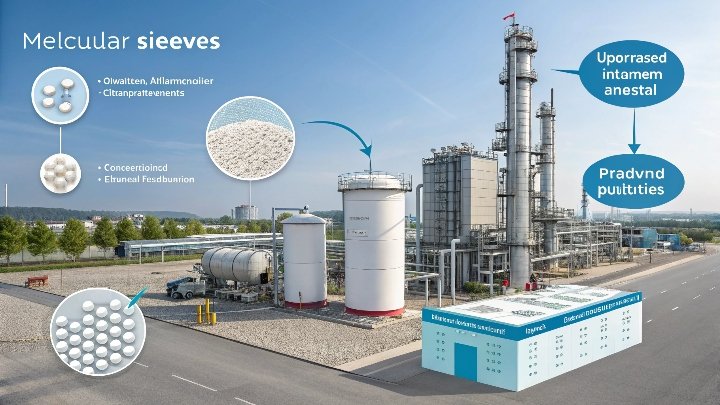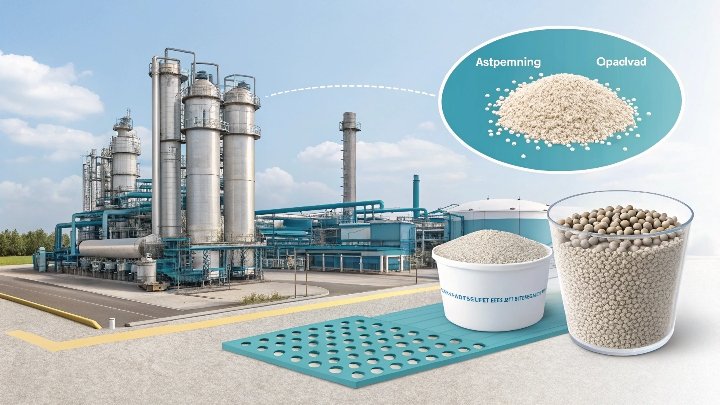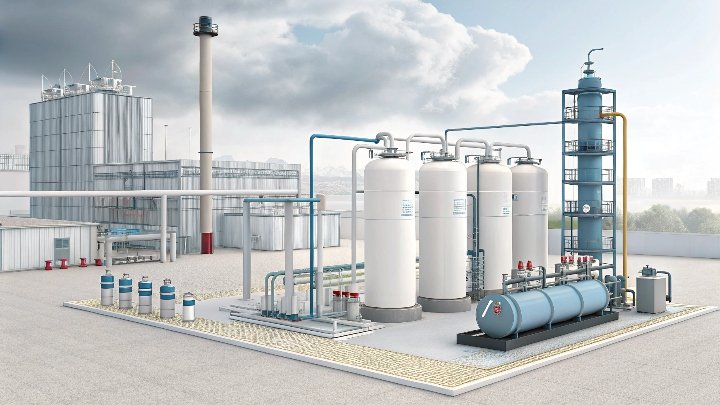Natural gas purification is a critical step in making gas suitable for various industrial uses, but not all purification methods are equal. Many plants still rely on outdated systems, leading to costly mistakes. One key solution to this issue is molecular sieves, which offer clear advantages over traditional methods like amine treatment. But why is this technology so beneficial?
Molecular sieves outperform traditional purification methods by providing superior efficiency, cost-effectiveness, and environmental benefits. They offer precise control over impurities, ensuring that natural gas meets the strictest quality and safety standards.
Natural gas purification is a complex process aimed at removing harmful contaminants such as sulfur, CO₂, and water, which can cause operational issues and affect the final product quality. Over the years, several methods have emerged to handle these challenges, but not all are created equal. For example, amine treatment has been a standard method for removing acid gases like CO₂ and H₂S, but it comes with high operating costs, maintenance issues, and environmental concerns. Enter molecular sieves—these highly effective adsorbents are revolutionizing the natural gas purification industry by providing a cleaner, more efficient alternative. So, how exactly do they compare with traditional methods, and why are more plants making the switch?
The $2.1M Mistake 68% of Gas Plants Make – And How Sieves Fix It?
Many gas plants continue to rely on amine treatment to remove CO₂ and H₂S. However, they overlook the hidden costs that this method brings, leading to expensive operational inefficiencies. What’s worse, it’s been estimated that 68% of these plants make this $2.1 million mistake annually. How can molecular sieves save the day?
Molecular sieves help eliminate the hidden costs of amine treatment by offering better efficiency, lower maintenance, and more precise gas purification. This can translate into millions of dollars in savings for gas plants each year.
When it comes to acid gas removal, amine systems have long been the go-to solution. However, these systems require substantial energy input and frequent maintenance, making them less cost-effective in the long run. Moreover, they often fail to achieve the ultra-pure gas that is required for certain applications. This is where molecular sieves come into play. By selectively adsorbing CO₂ and H₂S, sieves offer superior efficiency while consuming far less energy. They also require less maintenance, leading to lower operational costs. In fact, some plants have reported saving over $2 million annually after switching to molecular sieves, not only in energy and maintenance costs but also in improved uptime and fewer safety issues. With these benefits, it's clear why many gas plants are making the switch to molecular sieve technology.
Molecular Sieves: The Game-Changer
Molecular sieves are a class of adsorbents that can selectively remove specific molecules based on their size and shape. This makes them ideal for applications like natural gas purification, where precise control over impurities is essential. Unlike traditional amine treatment, which relies on chemical reactions to remove acid gases, molecular sieves physically adsorb unwanted molecules onto their surface. This process is highly efficient and can be fine-tuned to remove a wide range of impurities, including CO₂, H₂S, water, and even mercury.
This level of precision makes molecular sieves an invaluable tool in industries where natural gas purity is critical. For example, in cryogenic systems used for liquefied natural gas (LNG) production, even trace amounts of water or CO₂ can cause blockages or damage equipment. Molecular sieves, especially those with a pore size tailored to remove moisture, ensure that gas remains free of these contaminants, preventing costly equipment failures and maintaining optimal system performance.
Acid Gas Nightmares? How X-Type Sieves Saved a Texas Plant 900 Hours/Yr
Imagine a plant struggling with frequent shutdowns due to the corrosive effects of acid gases like H₂S and CO₂. For one Texas gas plant, this was a regular nightmare. That is, until they introduced X-type molecular sieves into their purification process. The results were nothing short of spectacular.
X-type molecular sieves solved the Texas plant’s acid gas problems, saving them 900 hours per year in downtime and improving overall gas quality. These sieves effectively captured acid gases, offering a more reliable and cost-efficient solution than traditional methods.
The introduction of X-type molecular sieves into the plant’s acid gas removal system was a game-changer. These sieves, known for their high adsorption capacity and efficiency, were able to remove both CO₂ and H₂S with remarkable precision. The plant saw a dramatic reduction in acid gas-related shutdowns, which had previously led to lengthy downtime and lost productivity. Over the course of a year, this saved the plant 900 hours in downtime—equating to substantial cost savings. Moreover, the gas that was being purified met the strictest quality standards, ensuring that the plant could continue operations without concerns about the safety or integrity of downstream equipment.
Why X-Type Sieves?
X-type molecular sieves are particularly well-suited for applications that require the removal of both large and small molecules. Their unique pore structure allows them to efficiently adsorb a range of gases, including CO₂ and H₂S, which are common contaminants in natural gas. By using X-type sieves, plants can achieve ultra-low levels of acid gases, making them ideal for high-purity applications like LNG production. Their ability to function efficiently at a variety of temperatures and pressures further enhances their versatility and reliability, providing gas plants with a robust solution to their acid gas removal needs.
Molecular Sieves vs. Amine Treatment: Why Shale Gas Giants Are Switching
Shale gas production has surged in recent years, and with it, the need for efficient natural gas purification methods. Many shale gas giants are now making the switch from traditional amine treatment to molecular sieves. But why?
Molecular sieves are becoming the preferred choice for shale gas producers due to their superior efficiency, lower maintenance costs, and ability to meet stringent purity standards.
Amine treatment has long been the standard for acid gas removal in natural gas processing, particularly in shale gas production. However, the process comes with several challenges, including high energy consumption, frequent maintenance, and less precise control over gas purity. As shale gas production ramps up, these drawbacks are becoming increasingly costly and inefficient.
In contrast, molecular sieves offer a more reliable, cost-effective solution. They require less energy, have longer service lives, and can operate more efficiently over time. Additionally, their ability to selectively adsorb impurities like CO₂ and H₂S allows shale gas producers to achieve higher-quality gas, meeting the stringent purity standards demanded by both the market and regulatory bodies. This has made molecular sieves a popular choice for shale gas giants looking to optimize their operations and reduce costs.
Why the Shift?
The shift from amine treatment to molecular sieves is driven by a combination of factors, including operational efficiency, cost savings, and environmental considerations. Shale gas producers are looking for ways to streamline their operations, minimize downtime, and reduce maintenance costs—all of which can be achieved with molecular sieve technology. Furthermore, as environmental regulations continue to tighten, molecular sieves provide a more sustainable solution by minimizing energy consumption and reducing emissions.
Conclusion
Molecular sieves are rapidly becoming the go-to solution for natural gas purification. Their superior efficiency, cost-effectiveness, and environmental benefits make them a more attractive choice than traditional methods like amine treatment. As the industry continues to evolve, molecular sieves will play a key role in shaping the future of natural gas processing.






